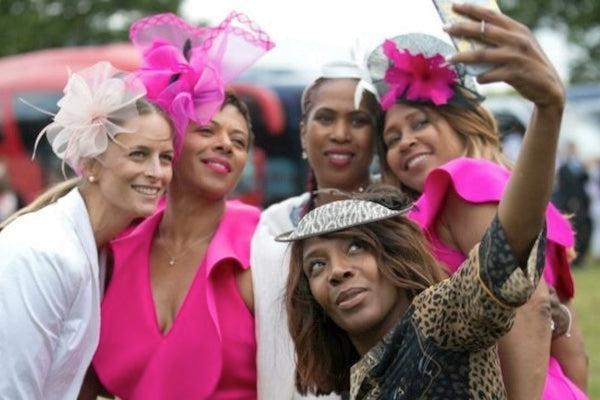Your Cart is Empty
Free UK Delivery | Save 10% On Clutch Bags when you buy any Fascinator or Hat
Free UK Delivery | Save 10% On Clutch Bags when you buy any Fascinator or Hat
Free UK Delivery | Save 10% On Clutch Bags when you buy any Fascinator or Hat
Free UK Delivery | Save 10% On Clutch Bags when you buy any Fascinator or Hat
June 04, 2024 4 min read

It’s that time of year again and with Royal Ascot just around the corner, fans gear up for one of the biggest events in the horse racing calendar. This spectacular festival of racing will span five days, with over 300,000 spectators expected to attend the event which runs from Tuesday, June 18th and concluding on Saturday June 22nd. Popular races will include The Platinum Jubilee Stakes, and The Price of Wales Stakes which both offer a whopping £1million in prize money.
Fashion plays a big part of the Royal Ascot five-day bonanza with attendees expected to dazzle us with their finest racecourse attire, worn with an Ascot fascinator or Ascot Hats. Royal Ascot Ladies Day which takes place on 20th June 2024 is where you can expect too see the most glamorous headwear and headpieces such as Fascinators, Hatinators, and Ladies Day Hats.
There is no official dress code for the Windsor Enclosure but guests are encouraged to wear smart daywear. For the Ladies, Hats and Fascinators are encouraged and a jacket and collared shirt is recommended for the men. For the Royal Enclosure the rules can be stricter so it is alway best to check on the Royal Ascot website as the rules can change each year. For 2024 the Royal Ascot dress code suggests that a headpiece or hair fascinator may be worn as an alternative to an occasion hat without any size requirements.
Royal Ascot is a world-renowned horse racing event that has been held annually for over 300 years. The event is held at Ascot Racecourse, a historic racecourse located in the county of Berkshire, England. This prestigious event is not only famous for its exhilarating horse racing but also for its fashion, pageantry, and royal patronage. Lets look a little more into take a the history of Royal Ascot and how it has evolved over the years.
The origins of Royal Ascot can be traced back to 1711 when Queen Anne saw the potential for horse racing at Ascot while out riding in the area. She ordered the construction of a new racecourse on the site and held the first race meeting there in August of that year. The race meeting was an instant success, and the course quickly gained a reputation as a premier racing venue in England
Over the years, Royal Ascot has become more than just a horse racing event. It has become a social event that attracts the high society and the royalty of Britain. In 1768, King George III attended the races, and from then on, the event became known as the Royal Meeting. Since then, every reigning monarch has attended the event at least once, and it is now a highlight of the British social calendar.
During the 19th century, the popularity of horse racing grew, and so did the crowds at Royal Ascot. The event became a showcase for the latest fashions, and the dress code became increasingly formal. The top hats and tails for men and extravagant hats, millinery and headpieces for women became a staple of the event.
The 20th century saw Royal Ascot go through several changes, reflecting the times. In the early 1900s, the event was canceled due to the First World War. It resumed in 1919, but the following year saw the introduction of the black armband in memory of the fallen. In 1955, the Queen introduced the Royal Procession, where she and her entourage would parade in carriages down the racecourse before the start of the first race. The Royal Enclosure was also established, becoming a highly exclusive area for the upper echelon of society and has strict rules on dress code and headwear such as as Hatinators or Ascot hats.
Today, Royal Ascot is a five-day event that takes place in June, with each day featuring six races. The event regularly attracts over 300,000 visitors annually, including members of the royal family, celebrities, and high society. The dress code remains strict, with men required to wear top hats and tails, and women wearing formal dresses and hats for the races, or a hatinator or fascinator.
Over the years, Royal Ascot has produced some of the most iconic moments in horse racing history. The most successful horse in the history of the event is Yeats, who won the Gold Cup four times in a row from 2006 to 2009. Other notable horses include Black Caviar, who won the Diamond Jubilee Stakes in 2012, and Frankel, who won the Queen Anne Stakes in 2012.
In conclusion, Royal Ascot has a long and storied history dating back over 300 years. What started as a simple horse racing event has become one of the most prestigious and exclusive social events in the world. With its rich history and royal patronage, Royal Ascot is an event that will continue to captivate and inspire horse racing fans and fashion enthusiasts alike for many years to come.
If you’re lucky enough got your hands on some Ascot tickets for this years event, explore our popular selection of races fascinator and racing hats and get the stylish look you need befitting to this glamorous occasion.
Comments will be approved before showing up.
Sign up to for the latest offers, promotions and new product updates